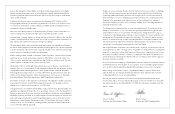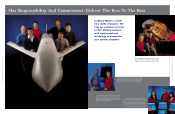Lockheed Martin 2001 Annual Report Download - page 15
Download and view the complete annual report
Please find page 15 of the 2001 Lockheed Martin annual report below. You can navigate through the pages in the report by either clicking on the pages listed below, or by using the keyword search tool below to find specific information within the annual report.
Lockheed Martin Corporation
December 31, 2001
MANAGEMENT’S DISCUSSION AND ANALYSIS OF FINANCIAL CONDITION AND RESULTS OF OPERATIONS
Lockheed Martin’s broad mix of programs and capabili-
ties makes it a likely beneficiary of any increases in defense
spending. The Corporation’s product areas and programs
include missile defense, space intelligence, precision muni-
tions, combat systems (air, land and sea-based) and aircraft.
In terms of size and long-term potential impact, two of the
Corporation’s most important programs are the F-22 fighter
aircraft program and the Joint Strike Fighter (JSF) program.
The Corporation was awarded the JSF contract in October
2001. In addition, Lockheed Martin is represented in virtually
every aspect of land, sea, air and space-based missile
defense, including the PAC-3 and THAAD programs. In the
areas of space intelligence and information superiority, it
has leadership positions on Milstar, Advanced Extremely
High Frequency (AEHF) and the Space-Based Infrared System-
High (SBIRS-H) programs, along with battle management
command and control capabilities. In airlift, the Corporation
has the C-130J program and is under contract to upgrade
the C-5 strategic airlift aircraft. Many of these programs are
very large and require significant funding over several budg-
etary cycles. There are risks associated with these and other
large, highly visible programs that are subject to appropria-
tion by Congress which, because of their magnitude, could
attract substantial focus as potential targets for reductions or
extensions of their funding to pay for other programs.
In addition, increased emphasis on homeland defense
may increase demand for utilization of the Corporation’s
capabilities in areas such as air traffic management, biohaz-
ard detection systems for postal equipment, ensuring informa-
tion systems security and other technical systems solutions.
Recent trends have indicated increased demand by federal
and civil government agencies for upgrading and investing in
new information technology systems, an area in which the
Corporation has continued to focus its resources.
Over the past several years, industry participants reacted
to historically shrinking defense budgets for procurement,
research and development by combining to maintain criti-
cal mass and achieve significant cost savings. The U.S.
Government has been generally supportive of industry
consolidation. Through its own consolidation activities, the
Corporation has been able to pass along savings to its
customers, principally the DoD. More recently, major aero-
space companies have focused their efforts on cost savings
and efficiency improvements, as well as generation of cash
to repay debt incurred during the period of consolidation.
Worldwide defense budgets have been declining over
the past decade. As a result, consolidation activities have
also occurred within the European aerospace industry,
resulting in fewer but larger and more capable competitors,
potentially resulting in an environment where there could
be less demand abroad for products from U.S. companies.
Such an environment could affect opportunities for European
partnerships and sales potential for U.S. exports. In addi-
tion, there has been some consolidation between U.S. and
European aerospace companies.
As a government contractor, the Corporation is subject
to U.S. Government oversight. The government may inves-
tigate and make inquiries of the Corporation’s business
practices and conduct audits of contract performance and
cost accounting. Depending on the results of these audits
and investigations, the government may make claims against
the Corporation. Under U.S. Government procurement
regulations and practices, an indictment of a government
contractor could result in that contractor being fined and/or
suspended for a period of time from eligibility for bidding
on, or for award of, new government contracts. A convic-
tion could result in debarment for a specified period of time.
Similar government oversight exists in most other countries
where the Corporation conducts business. Although the out-
come of such investigations and inquiries cannot be pre-
dicted, in the opinion of management, there are no claims,
audits or investigations pending against the Corporation
that are likely to have a material adverse effect on the
Corporation’s business or its consolidated results of opera-
tions, cash flows or financial position.
Recent procurement policy changes, such as an increase
in the progress payment rate and the use of performance-
based payments, have had a positive impact on the
Corporation’s financial position. However, the Corporation
remains exposed to other inherent risks associated with U.S.
Government contracting, including technological uncertainties
and obsolescence and dependence on annual Congressional
appropriation and allotment of funds. Many of the Corpora-
tion’s programs involve development and application of state-
of-the-art technologies aimed at achieving challenging goals.
Lockheed Martin Annual Report >>> 22
























